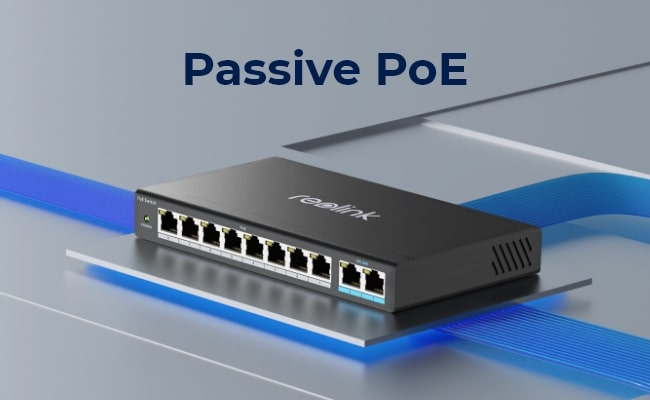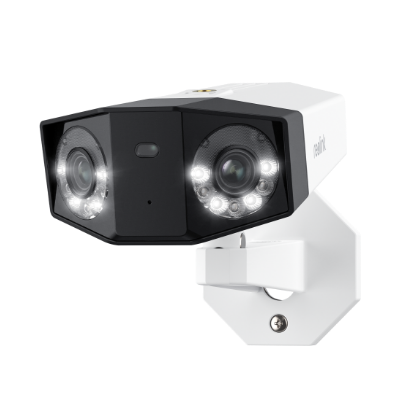Passive PoE: The Ultimate Guide

Power over Ethernet, or PoE, has become an essential technology for powering devices like Wi-Fi access points, IP cameras, and VoIP phones without the need to plug them into AC outlets. But did you know there are actually two types of PoE? Active PoE is the more common variety, using powered equipment to send electricity over Ethernet cables. Passive PoE, on the other hand, works differently.
In this article, we’ll unpack everything you need to know about this passive approach to transmitting both data and power over a single cable.
Part 1. What is Passive PoE?
Passive PoE refers to a type of Power over Ethernet (PoE) system that does not require any negotiation between the Power Sourcing Equipment (PSE) and Powered Device (PD). Instead, power is sent constantly over the Ethernet cable to the connected devices.
With passive PoE, a fixed DC voltage, usually 24V or 48V, is supplied on the spare wire pairs on an Ethernet cable. This provides continuous power to PoE devices without any intelligent power management. Passive PoE is simple, cost-effective, and easy to implement, making it popular for powering IP cameras, Wi-Fi access points, VoIP phones, and other IoT devices.
For example, the upcoming Reolink 16MP dual-lens security camera, the Duo 3 PoE can be connected to the Reolink NVR and offers you unparalleled clarity.
Groundbreaking 16MP Dual-Lens PoE Camera
16MP UHD, Dual-Lens, Motion Track, 180° Wide Viewing Angle, Power over Ethernet, Color Night Vision.
Part 2. Features of 24V Passive PoE
Passive PoE systems typically operate at 24V DC as this voltage offers a good balance between power output, cable length, safety, and cost. Let's look at some key features of passive 24V PoE solutions.
Voltage Level
24V DC is a common industrial automation control voltage. At this level, passive PoE can supply reasonable power safely over longer cable runs. The maximum current at 24V is generally 1A or less. The exact voltage drop depends on the cable quality and length.
PSE
The Power Sourcing Equipment (PSE) in 24V passive PoE is very simple. It does not require complex circuitry to detect and provide power to connected devices. A basic 24V power supply can act as the PSE by connecting directly to the spare wire pairs in the Ethernet cable.
PD
For powered devices (PDs), a PoE 24v passive module extracts power from the spare wire pairs. It will typically provide some basic DC-DC conversion and protection functions. Being passive, this module lacks negotiation ability and instead draws a fixed power level.
Applications
The simplicity and cost-effectiveness of passive 24v PoE make it suitable for lower-power IoT endpoints. These include PoE IP cameras requiring 10W to 25W, Wi-Fi access points up to 30W, and VoIP phones below 12W. Outdoor wireless bridge links are also good applications for passive PoE.
Part 3. Passive PoE vs. Active PoE: What’s the Difference?
While both provide power over Ethernet cables, passive PoE and active PoE utilize different methods. Let's explore some key differences between these two PoE variants.
Active PoE refers to the IEEE 802.3af/at/bt standards. This negotiates power levels between PSE and PD, can vary voltage based on the PD’s needs, and has advanced power management features. In contrast, passive PoE is much simpler but also limited in capabilities.
1. Negotiation
A core difference between passive PoE vs active is that active PoE performs auto-negotiation between the PSE and PD to determine the precise power the PD requires. This negotiation ensures proper interoperability between devices.
Passive PoE lacks any negotiation capability due to its simplicity. The PSE continuously sends a fixed voltage to connected PoE devices.
2. Voltage and Current
Active PoE offers higher flexibility in terms of voltage and power delivered to the PD, programmatically supplying between 3W to 90W. It leverages Layer 2 auto-negotiation to match the PD requirements. It is also the major difference between passive vs active PoE.
3. Standardization
The IEEE has standardized active PoE with 802.3af/at/bt, laying out specifications for capabilities, power levels, electrical safety, etc. This ensures cross-vendor interoperability for active PoE.
Passive PoE is not standardized, so equipment from different vendors may have subtle variations or incompatibilities. It is also a leading difference between active vs passive PoE.
4. Applications
The increased power delivery capacities, negotiation intelligence, and standardization of active PoE make it suitable for complex networks, business-class Access Points, pan/tilt/zoom security cameras, digital signage, etc.
Part 4. How Does a Passive PoE Injector Work?
A passive PoE injector is one of the main components facilitating the transmission of power along with data over an Ethernet cable. But how do these devices function exactly?
Passive PoE injectors work by combining DC power together with Ethernet data signals within the cable. They leverage the spare wire pairs in the CAT5/6 cable. A basic injector connects to a power supply on one side. This is typically a 24V or 48V SMPS unit. The injector then combines this DC supply with the existing data transmission pairs - pins 1, 2, 3, and 6.
The key functionality of the injector is maintaining electrical isolation between the powered spare pairs and data pairs. This avoids any interference or damage. Common isolation methods include transformer coupling or opto-isolators.
Part 5. How to Choose the Right Passive PoE Switch
When constructing a passive PoE network, the PoE switch you select is a pivotal component. The switch needs to reliably deliver power to all connected devices while handling data transmission. Here are some key aspects to evaluate when choosing a passive PoE switch:
Port Capacity
The port capacity must be adequate for the number of networked PoE devices in your system. Support for 8, 16, or 24 ports is common.
Speed and Bandwidth
Match the switching speed and backplane bandwidth to the application network traffic needs while accommodating multiple connected devices. Common choices range from 10 Mbps to 1 Gbps speeds.
Power Output
Carefully calculate the overall worst-case power demand from connected cameras, VoIP phones, or other PoE endpoints. Select a PoE switch rated for higher power capacity than this peak demand.
Reliability Mechanisms
Choose a PoE switch that maintains high reliability using protection against power overloads, short circuits, high temperatures, etc.
Budget
Finally, balance features against budget constraints. Passive PoE switches cost significantly less than managed active PoE models with advanced capabilities. Without needing complex negotiation logic, passive switches emphasize value for money.
Part 6. Bonus: What is PoE Atlas Passive Tree?
The Atlas Passive Skill Tree is a passive skill tree specific to the Atlas of Worlds end-game mapping system in the online game Path of Exile.
Progressing through maps allows the player to obtain passive skill points to allocate in the Atlas tree. This enhances the rewards and fights of maps within the Atlas endgame.
The Atlas tree has over 600 skill nodes to specialize in, including several Atlas keystones and Gateways, which allow traversing to the opposite side of the tree to a connected Gateway. Every map completed, as well as various endgame quests/encounters, earn the player an Atlas skill point.
FAQs
What does passive PoE mean?
Passive PoE refers to delivering power over Ethernet cables without any intelligent negotiation between devices.
Is passive PoE safe?
Yes, implemented properly, passive PoE is generally safe. It utilizes DC voltages below 60V, which have lower risks. However, care must be taken to avoid overloads and install surge/short protection.
How long can a passive PoE cable be?
For 24V DC supplies, passive PoE cables can typically extend around 100 meters or 330 feet. The exact distance depends on the power requirements of the powered device and cable quality.
Conclusion
In this comprehensive guide, we covered all key aspects of passive Power over Ethernet technology - from its working principle and component functionality to designing and installing robust passive PoE networks. PoE helps future-proof connectivity for edge IoT systems. Passive PoE specifically emphasizes cost-efficiency plus simplicity.
With this foundational knowledge, you can confidently adopt passive PoE solutions for surveillance cameras, wireless access points, IP phones, and industrial data acquisition devices. Do you know the differences between Passive PoE and Active PoE before? Share your thougts with us in the comment section below! We'd love to hear from you!
Search
Be in the Know
Security insights & offers right into your inbox

